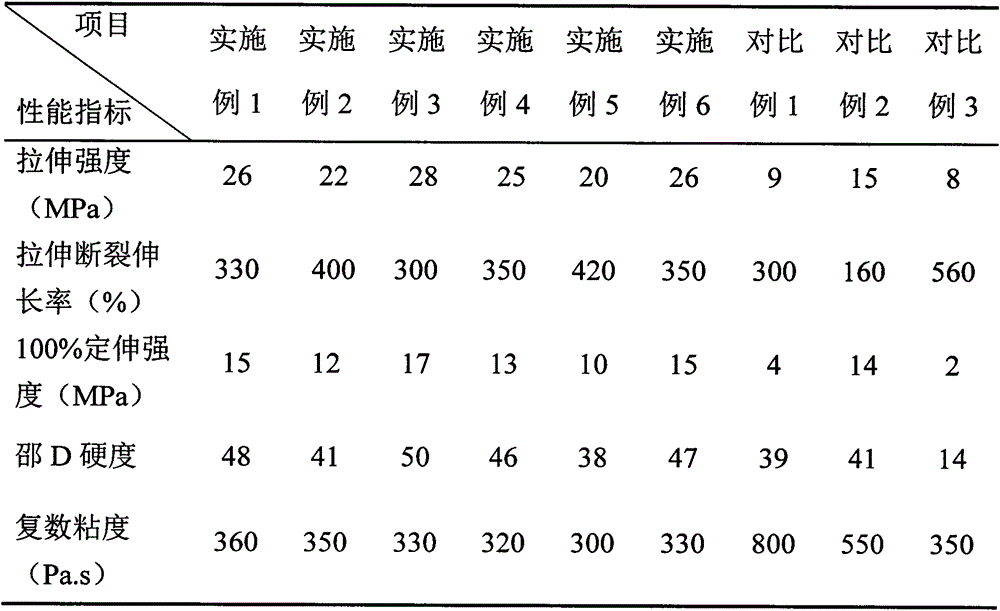Thermoplastic vulcanized rubber based on polylactic acid, and preparation method thereof
A technology of thermoplastic vulcanization and polylactic acid, which is applied in the field of polymer materials, can solve problems such as the unclear influence of polyester elastomer rubber properties, and achieve the effects of low cost, high biomass content, and high strength
- Summary
- Abstract
- Description
- Claims
- Application Information
AI Technical Summary
Problems solved by technology
Method used
Image
Examples
Embodiment 1
[0021] 300 g of ethylene-vinyl acetate rubber with a vinyl acetate content of 50%, 3 g of dicumyl peroxide, 2.5 g of 2,2,6,6-tetramethylpiperidine-nitrogen-oxide, 2,2, 2.5 g of 4-trimethyl-1,2-dihydroquinoline polymer was mixed with an internal mixer for 10 minutes to obtain a rubber compound (blending conditions: the temperature was 80° C., and the rotor speed was 50 rpm), and then Mixed rubber and polylactic acid 200g, dibutyl sebacate 15g, 1010 antioxidant 2.5g and 168 antioxidant 0.5g obtain thermoplastic vulcanized rubber (blending condition: temperature is 170 °C, the rotor speed is 50 rpm). The thermoplastic vulcanizate was formed by hot pressing with a flat vulcanizer to obtain a 1 mm thick sheet of thermoplastic vulcanizate, which was cut into standard specimens for mechanical performance testing according to relevant standards. The test results are listed in Table 1.
Embodiment 2
[0023] 350 g of ethylene-vinyl acetate rubber with a vinyl acetate content of 70%, 7 g of 2,5-dimethyl-2,5-di(t-butylperoxy)hexane, 2,2,6,6- Tetramethylpiperidine-nitrogen-oxide 1.5g, 2,2,4-trimethyl-1,2-dihydroquinoline polymer 2.5g were mixed at 40-60°C for 10 Obtain the mixed rubber in 12 minutes, then the mixed rubber and polylactic acid 150g, dioctyl adipate 15g and 1010 antioxidant 1.5g obtain thermoplastic vulcanizate in internal mixer for 12 minutes (blending condition: temperature is 180°C, the rotor speed is 100 rpm). The thermoplastic vulcanizate was formed by hot pressing with a flat vulcanizer to obtain a 1 mm thick sheet of thermoplastic vulcanizate, which was cut into standard specimens for mechanical performance testing according to relevant standards. The test results are listed in Table 1.
Embodiment 3
[0025] 300 g of ethylene-vinyl acetate rubber with a vinyl acetate content of 50%, 6 g of 2,5-dimethyl-2,5-di(t-butylperoxy)hexane, 2,2,6,6- Tetramethylpiperidine-nitrogen-oxide 1g, 2,2,4-trimethyl-1,2-dihydroquinoline polymer 1g mixed with internal mixer for 10 minutes to obtain rubber compound (blending condition: temperature 80°C, the rotor speed is 50 rev / min), then the compounded rubber, 200g of polylactic acid, 10g of tributyl citrate, 1g of 1010 antioxidant and 1g of 168 antioxidant were melt blended in the internal mixer for 10 Minutes to obtain thermoplastic vulcanizate (blending conditions: the temperature is 180 ° C, the rotor speed is 50 rpm). The thermoplastic vulcanizate was formed by hot pressing with a flat vulcanizer to obtain a 1 mm thick sheet of thermoplastic vulcanizate, which was cut into standard specimens for mechanical performance testing according to relevant standards. The test results are listed in Table 1.
PUM
| Property | Measurement | Unit |
|---|---|---|
| tensile strength | aaaaa | aaaaa |
| thickness | aaaaa | aaaaa |
Abstract
Description
Claims
Application Information
 Login to View More
Login to View More - Generate Ideas
- Intellectual Property
- Life Sciences
- Materials
- Tech Scout
- Unparalleled Data Quality
- Higher Quality Content
- 60% Fewer Hallucinations
Browse by: Latest US Patents, China's latest patents, Technical Efficacy Thesaurus, Application Domain, Technology Topic, Popular Technical Reports.
© 2025 PatSnap. All rights reserved.Legal|Privacy policy|Modern Slavery Act Transparency Statement|Sitemap|About US| Contact US: help@patsnap.com

